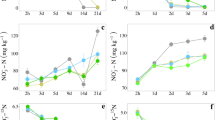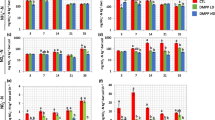Abstract
The effect of the nitrification inhibitor 3,4-dimethylpyrazole phosphate (DMPP) on N transformations and composition of ammonia-oxidizing bacteria (AOB) communities was investigated at the centimeter scale in a microcosm experiment under laboratory conditions. After 28 days, samples were collected from soil treated with urea or urea and DMPP at increasing distance from the fertilizer zone; this distance ranged from 0 to 5 cm in both horizontal and vertical directions. The results showed that DMPP application significantly increased soil pH and NH +4 -N and mineral N (NH +4 -N, NO −3 -N, and NO −2 -N) concentrations but decreased (NO −3 + NO −2 )-N concentration, and such effect was decreased by increasing the distance from the fertilizer zone. Fingerprint profiles of denaturing gradient gel electrophoresis showed that the number of bands decreased by increasing the distance from the fertilizer zone due to decreasing NH +4 -N concentrations in the urea treatment. Compared to urea applied alone, DMPP application increased NH +4 -N concentrations and decreased AOB diversity from 0 to 3 cm but promoted diversity from 3 to 5 cm distance from the fertilizer zone. A phylogenetic analysis showed that AOB communities were dominated by Nitrosospira cluster 3. Therefore, the nitrification inhibitor DMPP modified the composition of AOB communities by increasing the distance from the fertilizer zone and this probably was related to the changes in soil pH and inorganic N concentration.




Similar content being viewed by others
Abbreviations
- DMPP:
-
3,4-Dimethylpyrazole phosphate
- AOA:
-
Ammonia-oxidizing archaea
- AOB:
-
Ammonia-oxidizing bacteria
- DCD:
-
Dicyandiamide
- DGGE:
-
Denaturing gradient gel electrophoresis
- PCR:
-
Polymerase chain reaction
References
Azam F, Benckiser G, Muller C, Ottow JCG (2001) Release, movement and recovery of 3,4-dimethylpyrazole phosphate (DMPP), ammonium, and nitrate from stabilized nitrogen fertilizer granules in a silty clay soil under laboratory conditions. Biol Fertil Soils 34:118–125
Bollmann A, Laanbroek HJ (2001) Continuous culture enrichments of ammonia-oxidizing bacteria at low ammonium concentrations. FEMS Microbiol Ecol 37:211–221
Bremner JM (1965) Inorganic forms of nitrogen. In: Black CA (ed) Methods of soil analysis. American Society of Agronomy, Madison, pp 1179–1237
Cabrera ML, Kissel DE, Bock BR (1991) Urea hydrolysis in soil: effects of urea concentration and soil pH. Soil Biol Biochem 23:1121–1124
Chen D, Suter HC, Islam A, Edis R (2010) Influence of nitrification inhibitors on nitrification and nitrous oxide (N2O) emission from a clay loam soil fertilized with urea. Soil Biol Biochem 42:660–664
Chen X, Zhang LM, Shen JP, Wei WX, He JZ (2011) Abundance and community structure of ammonia-oxidizing archea and bacteria in an acid paddy soil. Biol Fertil Soils 47:323–331
Dawar K, Zaman M, Rowarth JS, Blennerhassett J, Turnbull MH (2011) Urea hydrolysis and lateral and vertical movement in the soil: effects of urease inhibitor and irrigation. Biol Fertil Soils 47:139–146
Di HJ, Cameron KC (2012) How does the application of different nitrification inhibitors affect nitrous oxide emissions and nitrate leaching from cow urine in grazed pastures? Soil Use Manage 28:54–61
Di HJ, Cameron KC, Shen JP, Winefield CS, O'Callaghan M, Bowatte S, He JZ (2009) Nitrification driven by bacteria and not archaea in nitrogen-rich grassland soils. Nat Geosci 2:621–624
Di HJ, Cameron KC, Shen JP, Winefield CS, O'Callaghan M, Bowatte S, He JZ (2010) Ammonia-oxidizing bacteria and archaea grow under contrasting soil nitrogen conditions. FEMS Microbiol Ecol 72:386–394
Ding WX, Yu HY, Cai ZC (2011) Impact of urease and nitification inhibitors on nitrous oxide emissions from fluvo-aquic soil in the North China Plain. Biol Fertil Soils 47:91–99
Dinnes DL, Karlen DL, Jaynes DB, Kaspar TC, Hatfield JL, Colvin TS, Cambardella CA (2002) Nitrogen management strategies to reduce nitrate leaching in tile-drained midwestern soils. Agron J 94:153–171
Fettweis U, Mittelstaedt W, Schimansky C, Führ F (2001) Lysimeter experiments on the translocation of the carbon-14-labelled nitrification inhibitor 3,4-dimethylpyrazole phosphate (DMPP) in a gleyic cambisol. Biol Fertil Soils 34:126–130
Jia ZJ, Conrad R (2009) Bacteria rather than Archaea dominate microbial ammonia oxidation in an agricultural soil. Environ Microbiol 11:1658–1671
Khasawneh FE, Soileau JM (1969) Soil preparation and sampling techniques for studying ion movement. Soil Sci Soc Am J 33:476–477
Kim YM, Park D, Lee DS, Park JM (2008) Inhibitory effects of toxic compounds on nitrification process for cokes wastewater treatment. J Hazard Mater 152:915–921
Kleineidam K, Kosmrlj K, Kublik S, Palmer I, Pfab H, Ruser R, Fiedler S, Schloter M (2011) Influence of the nitrification inhibitor 3,4-dimethylpyrazole phosphate (DMPP) on ammonia-oxidizing bacteria and archaea in rhizosphere and bulk soil. Chemosphere 84:182–186
Kowalchuk GA, Stephen JR (2001) Ammonia-oxidizing bacteria: a model for molecular microbial ecology. Annu Rev Microbiol 55:485–529
Kowalchuk GA, Stephen JR, DeBoer W, Prosser JI, Embley TM, Woldendorp JW (1997) Analysis of ammonia-oxidizing bacteria of the beta subdivision of the class Proteobacteria in coastal sand dunes by denaturing gradient gel electrophoresis and sequencing of PCR-amplified 16 S ribosomal DNA fragments. Appl Environ Microbiol 63:1489–1497
Kowalchuk GA, Stienstra AW, Heilig SJR, Woldendorp JW (2000) Changes in the community structure of ammonia-oxidizing bacteria during secondary succession of calcareous grasslands. Environ Microbiol 2:99–110
Leininger S, Urich T, Schloter M, Schwark L, Qi J, Nicol GW, Prosser JI, Schuster SC, Schleper C (2006) Archaea predominate among ammonia-oxidizing prokaryotes in soils. Nature 442:806–809
Li H, Liang X, Chen Y, Lian Y, Tian G, Ni W (2008) Effect of nitrification inhibitor DMPP on nitrogen leaching, nitrifying organisms, and enzyme activities in a rice-oilseed rape cropping system. J Environ Sci 20:149–155
Lu RK (1999) Microzone soil science—a possible new branch of soil science. Acta Pedol Sin 36:287–288
Malchair S, De Boeck HJ, Lemmens CMHM, Ceulemans R, Merckx R, Nijs I, Carnol M (2010) Diversity–function relationship of ammonia-oxidizing bacteria in soils among functional groups of grassland species under climate warming. Appl Soil Ecol 44:15–23
McCaig AE, Embley TM, Prosser JI (1994) Molecular analysis of enrichment cultures of marine ammonia oxidisers. FEMS Microbiol Lett 120:363–367
Mian IA, Riaz M, Cresser MS (2009) The importance of ammonium mobility in nitrogen-impacted unfertilized grasslands: a critical reassessment. Environ Pollut 157:1287–1293
Nicol GW, Leininger S, Schleper C, Prosser JI (2008) The influence of soil pH on the diversity, abundance and transcriptional activity of ammonia oxidizing archaea and bacteria. Environ Microbiol 11:2966–2978
Nieder R, Benbi DK, Scherer HW (2011) Fixation and defixation of ammonium in soils: a review. Biol Fertil Soils 47:1–14
O’Callaghan M, Gerard EM, Carter PE, Lardner R, Sarathchandra U, Burch G, Ghani A, Bell N (2010) Effect of the nitrification inhibitor dicyandiamide (DCD) on microbial communities in a pasture soil amended with bovine urine. Soil Biol Biochem 42:1425–1436
Pasda G, Hähndel R, Zerulla W (2001) Effect of fertilizers with the new nitrification inhibitor DMPP (3,4-dimethylpyrazole phosphate) on yield and quality of agricultural and horticultural crops. Biol Fertil Soils 34:85–97
Prosser JI (1990) Autotrophic nitrification in bacteria. In: Rose AH, Tempest DW (eds) Advances in microbial physiology. Academic Press, London, pp 125–181
Shen JP, Zhang LM, Zhu YG, Zhang JB, He JZ (2008) Abundance and composition of ammonia-oxidizing bacteria and ammonia-oxidizing archaea communities of an alkaline sandy loam. Environ Microbiol 10:1601–1611
Stephen JR, Kowalchuk GA, Bruns MV, McCaig AE, Phillips CJ, Embley TM, Prosser JI (1998) Analysis of beta-subgroup proteobacterial ammonia oxidizer populations in soil by denaturing gradient gel electrophoresis analysis and hierarchical phylogenetic probing. Appl Environ Microbiol 64:2958–2965
Suwa Y, Sumino T, Noto K (1997) Phylogenetic relationships of activated sludge isolates of ammonia oxidizers with different sensitivities to ammonium sulfate. J Gen Appl Microbiol 43:373–379
Tourna M, Freitag TE, Nicol GW, Prosser JI (2008) Growth, activity and temperature responses of ammonia-oxidizing archaea and bacteria in soil microcosms. Environ Microbiol 10:1357–1364
Verhamme DT, Prosser JI, Nicol GW (2011) Ammonia concentration determines differential growth of ammonia-oxidising archaea and bacteria in soil microcosms. ISME J 5:1067–1071
Wang SG, Hou YL, Guo W (2010) Responses of nitrogen transformation and microbial community composition to nitrogen enrichment patch. Pedobiologia 54:9–17
Webster G, Embley TM, Freitag TE, Smith Z, Prosser JI (2005) Links between ammonia oxidizer species composition, functional diversity and nitrification kinetics in grassland soils. Environ Microbiol 7:676–684
Weiske A, Benckiser G, Herbert T, Ottow JCG (2001) Influence of the nitrification inhibitor 3,4-dimethylpyrazole phosphate (DMPP) in comparison to dicyandiamide (DCD) on nitrous oxide emissions, carbon dioxide fluxes and methane oxidation during 3 years of repeated application in field experiments. Biol Fertil Soils 34:109–117
Wheatley RE, Caul S, Crabb D, Daniell TJ, Griffiths BS, Ritz K (2003) Microbial population dynamics related to temporal variations in nitrification in three arable fields. Eur J Soil Sci 54:707–714
Xu YG, Yu WT, Ma Q, Zhou H (2012) Responses of bacterial and archaeal ammonia oxidisers of an acidic luvisols soil to different nitrogen fertilization rates after 9 years. Biol Fertil Soils. doi:10.1007/s00374-012-0677-2
Zacherl B, Amberger A (1990) Effect of the nitrification inhibitors dicyandiamide, nitrapyrin and thiourea on Nitrosomonas europaea. Fert Research 22:37–44
Zaman M, Saggar S, Blennerhassett JD, Singh J (2009) Effect of urease and nitrification inhibitors on N transformation, gaseous emissions of ammonia and nitrous oxide, pasture yield and N uptake in grazed pasture system. Soil Biol Biochem 41:1270–1280
Zebarth BJ, Milburn PH (2003) Spatial and temporal distribution of soil inorganic nitrogen concentration in potato hills. Can J Soil Sci 83:183–195
Zerulla W, Barth T, Dressel J, Erhardt K, Horchler von Locquenghien K, Pasda G, Rädle M, Wissemeier A (2001) 3,4-Dimethylpyrazole phosphate (DMPP)—a new nitrification inhibitor for agriculture and horticulture. Biol Fertil Soils 34:79–84
Acknowledgments
We are grateful for the support from the National Foundation of Sciences in China (30970537, 40901118), the National Basic Research Program of China (2007CB109301), and PADA (Priority Academic Program Development of Jiangsu Higher Education Institutions). We thank Misses Jingjing Xu and Huan Chen for their help in the laboratory. We also thank Dr. Anne Baily from Teagasc, Environment Research Centre of Ireland for the comments that helped improve the language of the manuscript.
Author information
Authors and Affiliations
Corresponding author
Rights and permissions
About this article
Cite this article
Yang, J., Li, X., Xu, L. et al. Influence of the nitrification inhibitor DMPP on the community composition of ammonia-oxidizing bacteria at microsites with increasing distance from the fertilizer zone. Biol Fertil Soils 49, 23–30 (2013). https://doi.org/10.1007/s00374-012-0692-3
Received:
Revised:
Accepted:
Published:
Issue Date:
DOI: https://doi.org/10.1007/s00374-012-0692-3




